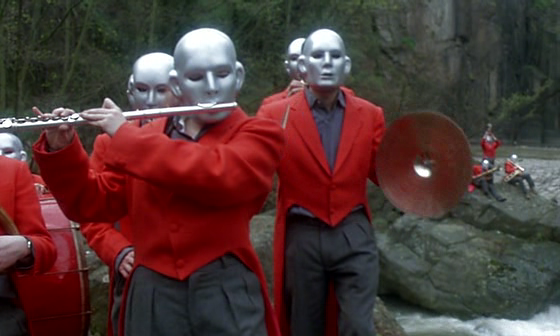
During a brief and unsuccessful attempt at becoming a flaneur, and working off some excess weight, I found myself in an unfamiliar part of my city. Making my way down a street of boxy concrete structures, overshadowed by the ancient volcanic presence of the igneous mass known as Arthur's Seat, I become aware of footsteps echoing my own. Behind me, to my surprise, was a man in raincoat, snap-brimmed fedora and aviator glasses, a detective or secret agent from a dated B-movie, as out-of-place on this modern street as a capybara in a haulage firm's accounting department (not the most elegant simile, but it will serve). The anonymous figure shadowing me might have been dismissed as a lone eccentric, except that up ahead I espied three elderly figures, two women and a man, who was sat upon a low wall. As I neared them, I became aware of a strange imposture: for the man was in fact no older than I, but clad in a full-face rubber mask creating the illusion of advanced years. As I approached, I heard one woman ask the other, "What's he got up like that for?"
And then the reply: "It's a Children's Meeting."
"It's a Children's Meeting." As if that were, you know, some kind of recognized thing. I had just crossed over into The Twilight Zone, or Freud's Uncanny, or, to put it another way, I had trespassed on the borders of Jean-Pierre Mocky's Litan (1982).

Mocky is perhaps best known in English-speaking terrain for his leading role in Franju's La tête contre les murs (1959), which he claims to have helped direct. That same year he launched his directing career proper with Les drageurs, in which Jacques Charrier and Charles Aznavour chase girls. Most Mocky films have tended to be either commercial comedies or commercial thrillers. Litan is neither.
In the town of Litan, a local festival or celebration day is occurring—townsfolk dress in masks, play music, make merry. Nora (Marie-José Nat) awakens from a nightmare and is convinced that she's prophesied some impending doom. Rushing to her husband, Jock (Mocky), who's job involves some kind of demolition work at "the Black Rocks," she plunges into a bigger nightmare, where telephone calls are routinely interrupted by crossed wires leading to mysterious messages from "the cemetery," and strange rotoscoped glow-worms lurk in the waters, waiting to dissolve those who fall in.
These glow-worms are maybe my least favorite component of the story—they look too much like special effects for a bizarre movie like this (one might as well say, "for this bizarre film", since there's none quite like it), and don't have the home-made charm of 1964's The Flesh Eaters, which were simply neg scratches etched into the celluloid, buzzing and flickering over the wounds of their screaming victims. But then, the overall aesthetic of Litan is midway between arthouse and kitsch horror, like Terry Gilliam caught morphing into Harry Kümel.

We see this in the wide-angle lens look, the soft-focus (augmented by the constant shifting fog or driving sheets of translucent mizzle gauzing the image) and the carnivalesque imagery, where masked revelers clutter every frame, sinister boy scouts cascade through the backgrounds, and vertiginous perspectives send striated towers and tenements shafting up at the sky or down towards the churning river.
"Masks, music and dances: in the town of Litan each year, one celebrates deaths thus." This opening title suggests the documentary creep of Robin Hardy and Anthony Schaffer's The Wicker Man, an anthropologic exploration of strange local customs, which may eventually include human sacrifice, but the proceedings are much more oneiric and indefinable here. Even Jock and Nora, the purportedly sane protags are, like dreamers, rather slow to register how demented their surroundings are, but they gradually accrue sufficient angst and déjà vu to wise up and get the hell out. Which is when they find, as in all the best anxiety dreams, that they can't.
In the midst of all this is a fragmented sci-fi conspiracy plot out of Quatermass or Doctor Who, left gloriously unresolved and unexplained like an idiot's plot synopsis. As the hero and heroine flee, we get snatches of their conversation over the roar of their jeep and realize they've figured the storyline out, which we never will. A church ending recalls Buñuel's The Exterminating Angel, but the jaunty, action-packed mood has been too theatrically flamboyant to feel like surrealism in earnest: it's more like the carnivalesque uncanny of an artist like James Ensor.
***
The Forgotten is a regular Thursday column by David Cairns, author of Shadowplay.